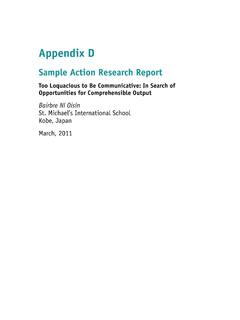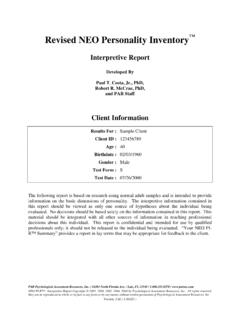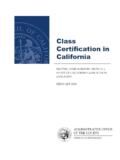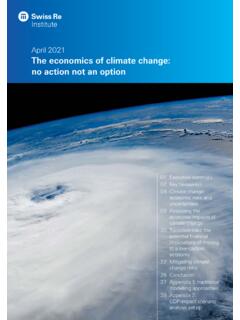Transcription of The Sexual Victimization of College Women
1 Department of Justice Office of Justice Programs National Institute of Justice research Report The Sexual Victimization of College Women Bonnie S. Fisher Bureau of Francis T. Cullen Justice Statistics Michael G. Turner Department of Justice Office of Justice Programs 810 Seventh Street Washington, DC 20531. Janet Reno Attorney General Daniel Marcus Acting Associate Attorney General Mary Lou Leary Acting Assistant Attorney General Julie E. Samuels Acting Director, National Institute of Justice Office of Justice Programs National Institute of Justice World Wide Web Site World Wide Web Site Bureau of Justice Statistics World Wide Web Site The Sexual Victimization of College Women Bonnie S.
2 Fisher Francis T. Cullen Michael G. Turner December 2000. NCJ 182369. Julie E. Samuels Acting Director National Institute of Justice Jan M. Chaiken Director Bureau of Justice Statistics Bernard V. Auchter Program Monitor National Institute of Justice Michael R. Rand Program Monitor Bureau of Justice Statistics The results from the College Women studies were supported under award 95 WT NX 0001 from the National Institute of Justice and award 97 MU MU 0011 from the Bureau of Justice Statistics, Department of Justice. Points of view in this document are those of the authors and do not necessarily represent the official position of the Department of Justice. Joanne Belknap, , worked with Professors Fisher and Cullen on award 95 WT NX 0001 in developing and revising the surveys and led the focus groups with Professor Fisher.
3 The National Institute of Justice and the Bureau of Justice Statistics are compo- nents of the Office of Justice Programs, which also includes the Bureau of Justice Assistance, the Office of Juvenile Justice and Delinquency Prevention, and the Office for Victims of Crime. Foreword This study contributes extremely important data to our understanding about the prevalence and nature of violence against Women in the United States. College campuses host large concentrations of young Women who are at greater risk for rape and other forms of Sexual assault than Women in the general population or in a comparable age group. Based on their findings, Bonnie Fisher and her colleagues estimate that the Women at a College that has 10,000 female students could experience more than 350 rapes a year.
4 A finding with serious policy implications for College administrators. Fisher also found that many Women do not characterize their Sexual victim- izations as a crime for a number of reasons (such as embarrassment, not clearly understanding the legal definition of rape, or not wanting to define someone they know who victimized them as a rapist) or because they blame themselves for their Sexual assault. The study reinforces the importance of many organizations' efforts to improve education and knowledge about sex- ual assault. A unique feature of this study, brought about by joint funding from our two agencies, is its parallel use of two different survey methods for learning about Sexual assault of Women .
5 The differences in estimated levels of Sexual assault that are associated with the methodological differences will help us design better and more accurate surveys in the future. Julie E. Samuels Acting Director National Institute of Justice Jan M. Chaiken Director Bureau of Justice Statistics iii Contents Foreword .. iii What we know about Sexual Victimization of College Women .. 2. Who was surveyed? .. 3. How was Sexual Victimization measured? .. 4. What types of Sexual Victimization were measured in the NCWSV study? .. 9. How extensive is rape among College Women ? .. 10. How do the NCWSV rape estimates compare with the rape estimates based on the National Crime Victimization Survey?
6 11. Do Women define their Victimization as a rape? .. 15. How extensive are other forms of Sexual Victimization ? .. 15. How extensive is prior Sexual Victimization ? .. 16. Do victims know their offenders? .. 17. When does Sexual Victimization occur? .. 18. Where does Sexual Victimization occur? .. 18. Are Women victimized on or off campus? .. 19. Do Sexual victims take protective actions during the incident? .. 19. Are victims hurt in the Victimization incidents? .. 22. Are some Women more at risk of being sexually victimized? .. 23. Do Women report Victimization incidents to the police? ..23. How extensive is stalking? .. 23. What is the nature of stalking incidents?
7 28. v Are some Women more at risk of being stalked? .. 28. What is the extent of visual and verbal Sexual Victimization ? .. 30. Conclusions .. 30. Notes .. 35. vi The Sexual Victimization of College Women D uring the past decade, concern over the Sexual Victimization of female College students has escalated. In part, the interest in this problem has been spurred by increasing attention to the Victimization of Women in general; until the relatively recent past, female victims received very little attention. However, this is no longer true. Terms such as date rape and domestic violence have entered the public lexicon and signify the unprecedented, if still insufficient, notice given to Women who have been victimized.
8 Attention to the Sexual Victimization of College Women , however, also has been prompted by the rising fear that College campuses are not ivory towers but, instead, have become hot spots for criminal activity. Researchers have shown that College campuses and their students are not free from the risk of criminal It is noteworthy that large concentrations of young Women come into contact with young men in a variety of public and private settings at various times on College campuses. Previous research suggests that these Women are at greater risk for rape and other forms of Sexual assault than Women in the general population or in a comparable age College Women might, therefore, be a group whose Victimization warrants special attention.
9 Recognizing these risks, the Congress passed the Student Right-to- Know and Campus Security Act of 1990 (hereafter referred to as the act). This legislation mandates that colleges and universities participating in Federal student aid programs prepare, publish, and distribute, through appropriate publications or mailings, to all current students and employees, and to any applicant for enrollment or employment upon request, an annual security report containing campus security policies and campus crime statistics for that institution (see 20 1092(f)(1)).3. Congress has maintained an interest in campus crime issues, passing legis- lation that requires higher educational institutions to address the rights of victims of Sexual Victimization and to collect and publish additional crime statistics ( , murder and nonnegligent manslaughter, arson).
10 For example, Congress amended the act in 1992 to include the Campus Sexual Assault Victims' Bill of Rights, which requires colleges and universities (1) to develop and publish as part of their annual security report their policies regarding the awareness and prevention of Sexual assaults and (2) to afford basic rights to Sexual assault The act was amended again in 1998. to include additional reporting obligations, extensive campus security-related provisions, and the requirement to keep a daily public crime log; some States 1. The Sexual Victimization of College Women already required a public log (Public Law 105 244).5 The 1998 amendments also officially changed the name of the act to the Jeanne Clery Disclosure of Campus Security Policy and Campus Crime Statistics Act.


















